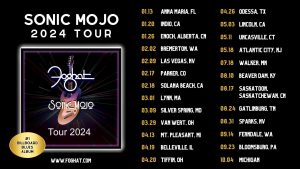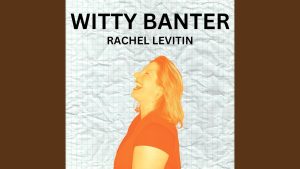
by Keith Valcourt
Since 1978, Canada’s second favorite prog rock sons SAGA have been rocking nonstop. Over their four decades in existence, they have sold over 10 million albums around the globe. In America, they are best known for their hits “On The Loose” and “Wind Him Up” from the 1981 album “Worlds Apart.” To mark the occasion of such a long and powerful career, a 2 CD compilation called “The Best Of SAGA: All Hits Since 1978” has just been released. In addition, the band’s entire catalog is being remastered for deluxe edition CDs and 180-gram virgin vinyl LPs. I caught up with SAGA’s founding member (and longest running player) Jim Crichton from his home in the Great White North to discuss SAGA’s long career, the effects of having a hit record, and why their U.S. label wanted a “hot chick” on the cover and not “an old guy with a map.”

Q: Where does today find you?
A: I’m in Port Stanley, Ontario Canada, but I lived in Los Angeles for 23 years.
Q: Do you have any favorite memories when you lived in California?
A: I had two studios in Van Nuys. I shared a parking lot with Sound City, which was a huge studio then. It’s gone now, but back then, they had produced thousands of records with almost a billion in sales. Every day, there was somebody interesting pulling into the parking lot. One day, I saw this beat up 30- or 40-year-old trashed pickup truck pull in and saw the passenger was Johnny Cash. And I looked over and Tom Petty was driving. What a cool parking lot.
Q: How have you been spending your time in quarantine?
A: For the first half of it, I was touching up the album we just released (“Symmetry.”) I’ve been in the mode of making a record. Except work on this album has extended somewhat.
Q: The album you mention is SAGA’s “Symmetry.” How long did it take to finish it?
A: It was about a year and a half. Quite a project. It was fun trying to make an acoustic record that offered something different. A little more fun than the norm of “just throw the strings on it and we’re done.” Beyond having Bach and Beethoven show up in the chorus and calling it an acoustic record.
Q: On that, you have stripped down versions of songs. Was that easy because that’s how the songs were created originally?
A: The majority of our songs are written on keyboards. They start with keyboard parts, and we build them into something that makes sense.
Q: Did you ever imagine when you started SAGA you would still be rocking 40 years later?
A: No. When we did the first album, we included songs with a chapter and number in them. We told the record company we needed to make at least four albums to complete the chapters. My plan was to at least make four albums. (Laughs)
Q: Are you comfortable being called a prog rock band?
A: I guess so. We’ve been called all kinds of things. I used to tell people we were a medieval funk band. I don’t care what they call us. It’s just a lot of effort and usually too many notes.
Q: Would you prefer to play in a band that only played three chords?
A: Oh no. No. My brain works in detail. I love counter point and counter melodies. I just can’t stop doing that. But if you leave me alone for too long, it will just get ridiculous.
Q: How well did Michael Sadler, a Welsh born singer, fit into your band of Canucks?
A: He was born in Wales but moved to Canada when he was very young – around the age of six. He grew up in a neighboring town. He was pretty much Canadian when I first met him.
Q: How did things change for the band when “On The Loose” became an MTV hit?
A: There was just a hell of a lot more going on, and we got to do the kind of shows we wanted to do, build the kind of stages we wanted to build, and spend all the money.
Q: What was your most excessive moment in the 80s?
A: Whenever we got a budget for the tour, we would get the best lights and best P.A. we could get. The band Genesis developed the Vari-Light. At the time, there were just twenty-two Vari-Lights on the entire planet, and we rented them all so we could have the most lights in Europe. We weren’t happy with European P.A. system, so we flew Showco over from Texas – the entire P.A. system to do a European tour. We were completely insane. We were not trying to bank the money. We spent every bit of the money we made trying to make our live shows bigger and bigger. Everything was spent toward the show.
Q: How important was producer Rupert Hine to the band’s success?
A: He was hugely important to our success. When I heard his first album, there were about a hundred things on the album I didn’t know how to do. I absolutely needed to meet him right away. He was somebody that would challenge you to make the music different. That’s the most important aspect to me to make it unique. If you hear a song and know who the band is in the first few seconds, then that band has done it. Rupert helped us become unique.
Q: Why was the “Worlds Apart” album cover changed in the U.S.?
A: Because the American label likes chicks on the covers of albums. (Laughs) They looked at our original art and said, “What’s up with this old guy on the cover? We’re going to put a chick on there with a red car. Let’s go!” They never pressured the band in any other way. They just wanted a cover that was more appealing to America. They got the cover they wanted. When they presented it to us, we said, “Good luck on your mission.” We didn’t fight them on it. I could see where a hot chick would be more appealing than an old guy with a map.
Q: Did having two hits (“On The Loose” and “Wind Him Up”) make it harder when it came to recording the next album?
A: Absolutely. Everyone wants the next one to do at least as well as the last one when trying to come up with a follow-up. We used to call it “Son Of Loose.” We didn’t want to write the same song again. We didn’t want to write “Son Of Loose.” You know when a band has done that. They just tweak the hit they had slightly. You can smell that right away. We always tried to write songs that had hooks. Sometimes we got carried away.
Q: There have been so many lineup changes, and you are the only constant in the band. How do you keep the band moving forward?
A: Well… You’ve hit on a nerve here because I have not played with the band for two years. I bowed out of the live thing. I did work on the album. Before COVID hit, I was pretty much done going to airports. In the beginning, I remember airports being a lot of fun. It was an exciting day every time you got to fly. But after about five or six years, it was like going to the dentist for twelve hours. I felt like I was in a “Groundhog Day” situation and decided to walk away.
Q: Do you miss the reaction of a live audience?
A: Yes. I love that. It’s the other 22 hours of the day. I’ve been in a band for almost 50 years, so at this point, I can just close my eyes and end up on any stage I want.
Q: Do you remember your first gig with SAGA?
A: We played The Tudor Tavern in Cambridge, Ontario. It’s a 500-seat club. There were sixty people in the venue. Forty of them were guests. The 20 other people were playing pool in the back of the room. We had 40 people watching us listening to two hours of music they had never heard before and had no idea what it was. It was a weird gig. (Laughs)
Q: Did you know the last gig you played with SAGA two years ago would be your last? And what was it like?
A: I knew it was. It was a show in Toronto, and it was funny. My old Moog started picking up RF (radio frequency) signals, and it sounded like a radio station was trying to cut into my Moog. I had to turn it just way and not put both hands over the top of it, or it started whining like a theremin. It was a nightmare, but I thought, “This is perfect for my last show.”
Q: How has the songwriting process between you and Michael evolved over the years?
A: Naturally. The whole band worked together in the writing process. Usually somebody started off with what we called a “mini song.” I always told the guys, “Don’t finish the song. Take the idea and keep it to 2 minutes long. Make a lot of those.” We would come with 60 mini songs, and it became obvious after we listened to all of them, so we would vote. And everyone would always settle on the same twelve songs. The ones that just get you. And then we would steal little bits from the others that didn’t make it.
Q: How involved are you in the remastering of the catalog?
A: Not directly in the remastering. We are just checking the artwork for typos and putting little comments in the liner notes.
Q: Do you ever go back and listen to your older albums?
A: Usually at somebody else’s house.
Q: What is the future of SAGA?
A: The guys toured last year, and the tour was completely sold out until COVID hit.
Q: Will you ever play with them live again?
A: It freaks me out not to show up. The day I stopped playing, I was the only one in the world who had seen every single show. To just stop was weird. It’s still weird. I don’t know if I will play again. I’m in a place right now where I’m trying to challenge myself to do stuff I’ve never done before. Some things are non-musical. I’m just finding a way to tweak my head into making things work.
Check out our Alchemical Weekly Spotify Playlist for more from SAGA, including songs from Symmetry.

Keith Valcourt is a Los Angeles based music and entertainment writer. He has interviewed thousands of celebrities in the worlds of music, film, TV and comedy for dozens of outlets including: L.A. Times, Washington Times, LFP Publishing, ChelseaCommunityNews.com, RetroRoadMap.com LaArtsOnline and more. Much More

Recent Articles March 21st. A day that I will always think of amazing album releases. DC-based musician, producer, and singer-songwriter, Rachel Levitin, released Witty Banter

Alchemical Records is a Washington, D.C. based music publication. We cover the Washington, D.C., Baltimore and Richmond, VA metro area music scenes, including band interviews, articles about your favorite musicians, new music and concert dates.